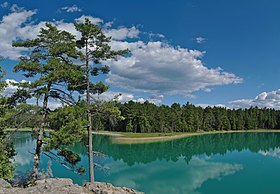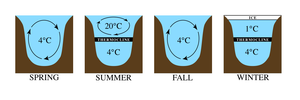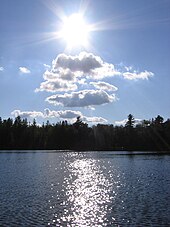

A meromictic lake is a lake which has layers of water that do not intermix. In ordinary, holomictic lakes, at least once each year, there is a physical mixing of the surface and the deep waters.
The term meromictic was coined by the Austrian Ingo Findenegg in 1935, apparently based on the older word holomictic. The concepts and terminology used in describing meromictic lakes were essentially complete following some additions by G. Evelyn Hutchinson in 1937.
Characteristics
| Lake zones |
|---|
| Lake stratification |
| Lake types |
| See also |

Most lakes are holomictic: at least once per year, the surface and the deep waters mix. In monomictic lakes, the mixing occurs once per year; in dimictic lakes, it occurs twice a year (typically spring and autumn), and in polymictic lakes, the mixing occurs several times a year. In meromictic lakes, the layers of water can remain unmixed for years, decades, or centuries.
Meromictic lakes can usually be divided into three sections or layers. The bottom layer is the monimolimnion; the waters in this portion of the lake circulate little, and are generally hypoxic and more saline than the rest of the lake. The top layer is the mixolimnion, and essentially behaves like a holomictic lake. The area in between is the chemocline, or chemolimnion.
The lack of mixing between layers creates radically different environments for life: the stratification, or stable layering, of lake waters means that the bottom layer receives little oxygen from the atmosphere, hence becomes depleted of oxygen. While the surface layer may have 10 mg/L or more dissolved oxygen in summer, the depths of a meromictic lake can have less than 1 mg/L. Very few organisms can live in such an oxygen-poor environment. One exception is purple sulfur bacteria. These bacteria, commonly found at the top of the monimolimnion in such lakes, use sulfur compounds such as sulfides in photosynthesis. These compounds are produced by decomposition of organic sediments in oxygen-poor environments. The monimolimnion is often rich in phosphorus and nitrogen. These factors combine to create an ideal environment for bacterial growth. The mixolimnion can have similar qualities. However, the types of bacteria that can grow at the surface are determined by the amount of light received at the surface.
A meromictic lake may form because the basin is unusually deep and steep-sided compared to the lake's surface area, or because the lower layer of the lake is highly saline and denser than the upper layers of water. However, human influence can lead to cultural meromixis occurring. The increased use of road salt as a deicing strategy, particularly in northern latitude regions, can disturb the natural mixing cycles in lakes by inhibiting mixing. As salt is flushed into aquatic systems at high concentrations in late winter/early spring, it accumulates in the deepest layer of lakes leading to incomplete mixing.
Stratification in meromictic lakes can be either endogenic or ectogenic. Endogenic means the patterns seen in the lake are caused by internal events, such as organic matter accumulating in the sediments and decaying, whereas ectogenic means the patterns seen are caused by external causes, like an intrusion of saltwater settling in the hypolimnion, preventing it from mixing.
The layers of sediment at the bottom of a meromictic lake remain relatively undisturbed because there is little physical mixing and few living organisms to agitate them. There is also little chemical decomposition. For this reason, cores of the sediment at the bottom of meromictic lakes are important in tracing past changes in climate at the lake, by examining trapped pollen grains and the types of sediments .
When the layers do mix for whatever reason, the consequences can be devastating for organisms that normally live in the mixolimnion. This layer is usually much smaller in volume than the monimolimnion. When the layers mix, the oxygen concentration at the surface will decrease dramatically. This can result in the death of many organisms, such as fish, that require oxygen.
Occasionally, carbon dioxide, methane, or other dissolved gases can build up relatively undisturbed in the lower layers of a meromictic lake. When the stratification is disturbed, as could happen from an earthquake, a limnic eruption may result. In 1986, a notable event of this type took place at Lake Nyos in Cameroon, causing nearly 1,800 deaths. In the following decades after this disaster, active research and management has been done to mitigate gas buildup in the future through the Nyos Organ Pipes Program (NOPP). The NOPP program placed large organ pipes into Lake Nyos, to reach the monimolimnion where harmful dissolved gases built up, that allow for gas release to the atmosphere, effectively degassing the monimolimnion. Since 2019, Lake Nyos has successfully been degassed to a nonhazardous concentration of dissolved gas. Paralleling Lake Nyos, Lake Kivu is another lake that poses a potentially fatal threat to the community. Some management strategies have suggested taking a different approach, moving gases from the monimolimnion to the mixolimnion, rather than degassing to the atmosphere through organ pipes.
While it is mainly lakes that are meromictic, the world's largest meromictic basin is the Black Sea. The deep waters below 50 m (160 ft) do not mix with the upper layers that receive oxygen from the atmosphere. As a result, over 90% of the deeper Black Sea volume is anoxic water. The Caspian Sea is anoxic below 100 m (330 ft). The Baltic Sea is persistently stratified, with dense, highly saline water comprising the bottom layer, and large areas of hypoxic sediments (see Baltic Sea hypoxia).






List of meromictic lakes

There are meromictic lakes all over the world. The distribution appears to be clustered, but this may be due to incomplete investigations. Depending on the exact definition of "meromictic", the ratio between meromictic and holomictic lakes worldwide is around 1:1000.
Africa
- Lake Nyos and Lake Monoun in Cameroon
- Lake Kivu in Rwanda and the Democratic Republic of the Congo
- Lake Tanganyika in Burundi, the Democratic Republic of the Congo, Tanzania and Zambia
- Lake Malawi, located between Malawi, Mozambique and Tanzania
Antarctica
- Lake Vanda in Ross Dependency
- 21 lakes, including Organic Lake in Vestfold Hills
Asia
- Lake Shira in the Republic of Khakassia, Russia
- Keracut Beach Lake, Penang National Park, northwest Penang island, Malaysia
- Jellyfish Lake, on Eil Malk in Palau
- Zigetangcuo Lake, a crenogenic lake in Nagqu, Tibet, China. It is the meromictic lake located at the highest altitude.
- Kaptai Lake, in Rangamati Hill District, at the southeastern part of Bangladesh. It was created by constructing a dam at Kaptai to set up a hydroelectric power plant.
- Lake Matano, Sulawesi island, Indonesia
Australia
Europe
- Kärntner Seen [de] (Alpine lakes in the Austrian province of Carinthia; studied by Ingo Findenegg in the 1930s).
- Alatsee near Füssen and Neuschwanstein Castle, Bavaria, Germany
- Lake Vähä-Pitkusta [fi] in Finland
- Lake Pakasaivo [fi] in Finland
- Lough Furnace in Ireland
- Salvatnet, Kilevann, Tronstadvatn, Birkelandsvatn, Rørholtfjorden, Botnvatn, Rørhopvatn and Strandvatn lakes in Norway
- Czarne Lake in Drawa National Park, Poland
- Lake Mogilnoye in Murmansk Oblast of Russia
- Lakes El Tobar and La Cruz in Spain
- Lake Cadagno, crenogenic, in Switzerland, and the location of the Alpine Biology Center
- Lac Pavin and Lac du Bourget in France
- The Black Sea – while not a lake – is also considered to be meromictic.
- Lake El Tobar in Cuenca (Spain)
- Lake La Cruz in Cuenca (Spain)
North America
- Canada
- Lake McKay in Ottawa, Ontario
- Lakes A and C1 on Ellesmere Island, Nunavut
- Blackcat Lake near Dorset, Ontario, in Frost Centre
- Crawford Lake near Milton, Ontario
- Picard Lake near Lakehurst, Ontario
- Mahoney Lake in the Okanagan Valley, British Columbia
- McGinnis Lake in Petroglyphs Provincial Park, Ontario
- Pink Lake in Gatineau Park, Quebec
- Powell Lake in the town of Powell River, British Columbia
- Sunfish Lake near Waterloo, Ontario
- Little Round Lake (Ontario) in Central Frontenac, Ontario
- Teapot Lake, Heart Lake Conservation Area, Brampton, Ontario. See also Heart Lake (Ontario)
- Central America
- Lake Atitlán, endorheic lake in the department of Sololá, Guatemala
- United States
- Ballston Lake, north northwest of Albany, New York
- Big Soda Lake, Nevada
- Brownie Lake in Minneapolis, Minnesota
- Canyon Lake near Big Bay, Michigan
- Chapel Lake, in Pictured Rocks National Lakeshore, near Munising, Michigan
- Great Salt Lake near Salt Lake City, Utah
- Green Lake and Round Lake in Green Lakes State Park near Syracuse, New York
- Hot Lake in Okanogan County, Washington
- Knaack Lake, Wisconsin
- Lake Mary, in the northwest corner of Vilas County, Wisconsin
- Lower Mystic Lake in Arlington and Medford, Massachusetts
- Redoubt Lake near Sitka, Alaska; one of North America's largest meromictic lakes
- Soap Lake in Washington
See also
References
- ^ Wetzel, Robert G. (2001). Limnology: Lake and River Ecosystems (Third ed.). New York: Academic Press. ISBN 978-0-12-744760-5.
- Lewis, William M. Jr. (1983). "A revised classification of lakes based on mixing" (PDF). Canadian Journal of Fisheries and Aquatic Sciences. 40 (10): 1779–1787. doi:10.1139/f83-207. Archived from the original (PDF) on 6 March 2009.
- Hakala, Anu (27 February 2004). "Meromixis as a part of lake evolution – observations and a revised classification of true meromictic lakes in Finland" (PDF). Boreal Environment Research. 9: 37–53. ISSN 1239-6095.
- Findenegg, Ingo (1935). "Limnologische Untersuchungen im Kärntner Seengebiete. Ein Beitrag zur Kenntnis des Stoffhaushaltes in Alpenseen". Internationale Revue der Gesamte Hydrobiologie (in German). 32: 369–423. As cited by Hakala (2004).
- Hutchinson, G. Evelyn (1937). "A contribution to the limnology of arid regions". Transactions of the Connecticut Academy of Arts and Sciences. 33: 47–132. As cited by Hakala (2004).
- Walker, K. F. (March 1974). "The Stability of Meromictic Lakes in Central Washington". Limnology and Oceanography. 19 (2): 209–222. Bibcode:1974LimOc..19..209W. doi:10.4319/lo.1974.19.2.0209. JSTOR 2834407.
- Lampert, Winfried & Sommer, Ulrich (1997). Limnoecology: The Ecology of Lakes and Streams. Translated by James F. Haney. Oxford University Press. ISBN 978-0-19-509592-0.
- Fry, Brian (January 1986). "Sources of Carbon and Sulfur Nutrition for Consumers in Three Meromictic Lakes of New York State". Limnology and Oceanography. 31 (1): 79–88. Bibcode:1986LimOc..31...79F. CiteSeerX 10.1.1.420.7035. doi:10.4319/lo.1986.31.1.0079. JSTOR 2836641. PMID 11539668.
- Stewart, K. M.; Walker, K. F.; Likens, G. E. (1 January 2009), "Meromictic Lakes", in Likens, Gene E. (ed.), Encyclopedia of Inland Waters, Oxford: Academic Press, pp. 589–602, doi:10.1016/b978-012370626-3.00027-2, ISBN 978-0-12-370626-3, retrieved 12 April 2024
- Sibert, Ryan J.; Koretsky, Carla M.; Wyman, Davina A. (2015). "Cultural meromixis: Effects of road salt on the chemical stratification of an urban kettle lake". Chemical Geology. 395: 126–137. Bibcode:2015ChGeo.395..126S. doi:10.1016/j.chemgeo.2014.12.010.
- Dupuis, Danielle; Sprague, Emily; Docherty, Kathryn M.; Koretsky, Carla M. (15 April 2019). "The influence of road salt on seasonal mixing, redox stratification and methane concentrations in urban kettle lakes". Science of the Total Environment. 661: 514–521. Bibcode:2019ScTEn.661..514D. doi:10.1016/j.scitotenv.2019.01.191. ISSN 0048-9697. PMID 30682604.
- Kjensmo, Johannes (1997). "[No title found]". Hydrobiologia. 347 (1/3): 151–159. doi:10.1023/A:1003035705729.
- Ladwig, Robert; Rock, Linnea A.; Dugan, Hilary A. (2023). "Impact of salinization on lake stratification and spring mixing". Limnology and Oceanography Letters. 8 (1): 93–102. Bibcode:2023LimOL...8...93L. doi:10.1002/lol2.10215. ISSN 2378-2242.
- Smoll, John P.; Brown, S. R.; McNeely, R. N. (1983). "Cultural disturbances and trophic history of a small meromictic lake from central Canada". Hydrobiologia. 103 (1): 125–130. doi:10.1007/BF00028439. ISSN 0018-8158.
- Krajick, Kevin (28 March 2003). "Africa's Davids and Goliaths". Science. 299 (5615): 2024–2026. doi:10.1126/science.299.5615.2024. ISSN 0036-8075. PMID 12663915.
- Boehrer, Bertram; Saiki, Kazuto; Ohba, Takeshi; Tanyileke, Greg; Rouwet, Dmitri; Kusakabe, Minoru (28 July 2021). "Carbon Dioxide in Lake Nyos, Cameroon, Estimated Quantitatively From Sound Speed Measurements". Frontiers in Earth Science. 9. doi:10.3389/feart.2021.645011. ISSN 2296-6463.
- Tassi, Franco; Rouwet, Dmitri (12 February 2014). "An overview of the structure, hazards, and methods of investigation of Nyos-type lakes from the geochemical perspective". Journal of Limnology. 73 (1). doi:10.4081/jlimnol.2014.836. ISSN 1723-8633.
- ^ Halbwachs, Michel; Sabroux, Jean-Christophe; Kayser, Gaston (2020). "Final step of the 32-year Lake Nyos degassing adventure: Natural CO2 recharge is to be balanced by discharge through the degassing pipes". Journal of African Earth Sciences. 167: 103575. doi:10.1016/j.jafrearsci.2019.103575.
- Hirslund, F.; Morkel, P. (2020). "Managing the dangers in Lake Kivu – How and why". Journal of African Earth Sciences. 161: 103672. Bibcode:2020JAfES.16103672H. doi:10.1016/j.jafrearsci.2019.103672.
- Hakala, Anu (2005). Paleoenvironmental and paleoclimatic studies on the sediments of Lake Vähä-Pitkusta and observations of meromixis (Doctoral dissertation). University of Helsinki. ISBN 952-10-2154-3.
- Gibson, John AE. (1999). "The meromictic lakes and stratified marine basins of the Vestfold Hills, East Antarctica." Antarctic Science 11.2, 175–192.
- Likens, Gene E., ed. (2010). Lake Ecosystem Ecology: A Global Perspective. Academic Press. p. 186. ISBN 978-0-12-382003-7. A derivative of the Encyclopedia of Inland Waters.
- "Lago di Cadagno". Centro Biologia Alpina (in Italian). 6 December 2014. Retrieved 23 February 2015.
- Jacquet, Stéphan; Briand, Jean-François; et al. (2003). "The proliferation of the toxic cyanobacterium Planktothrix rubescens following restoration of the largest natural French lake (Lac du Bourget)" (PDF). Harmful Algae. 4 (4): 651–672. CiteSeerX 10.1.1.541.2297. doi:10.1016/j.hal.2003.12.006. S2CID 51989121. Archived from the original (PDF) on 6 March 2009. Retrieved 13 May 2008.
- Lewis, Ted; Lamoureux, Scott F.; Normandeau, Alexandre; Dugan, Hilary A. (2017). "Hyperpycnal flows control the persistence and flushing of hypoxic high conductivity bottom water in a High Arctic lake". Arctic Science. doi:10.1139/as-2017-0022. hdl:1807/81139.
- Council Meeting - 19 Jan 2016 - Municipality of Trent Lakes
- Ontario Parks: Petroglyphs
- Sanderson, B.; Perry, K. & Pedersen, T. (15 June 1986). "Vertical Diffusion in Meromictic Powell Lake, British Columbia". Journal of Geophysical Research. 91 (C-6): 7647–7655. Bibcode:1986JGR....91.7647S. doi:10.1029/JC091iC06p07647.
- Smol, John P.; Brown, S. R.; McNeely, R. N. (1983). "Cultural disturbances and trophic history of a small meromictic lake from central Canada". Paleolimnology. pp. 125–130. doi:10.1007/978-94-009-7290-2_20. ISBN 978-94-009-7292-6.
- Heart Lake Conservation Area: Master Plan, Heart Lake Conservation Area Master Plan Advisory Committee, Conservation Land Planning Group, TRCA
- Toney, Jaime L.; Rodbell, Donald T.; Miller, Norton G. (2003). "Sedimentologic and palynologic records of the last deglaciation and Holocene from Ballston Lake, New York" (PDF). Quaternary Research. 60 (2): 189–199. Bibcode:2003QuRes..60..189T. doi:10.1016/S0033-5894(03)00093-0. S2CID 129373891. Retrieved 9 September 2018.
- Cloern, James E.; Cole, Brian E. & Oremland, Ronald S. (November 1983). "Autotrophic Processes in Meromictic Big Soda Lake, Nevada". Limnology and Oceanography. 28 (6): 1049–1061. Bibcode:1983LimOc..28.1049C. doi:10.4319/lo.1983.28.6.1049. JSTOR 2836268.
- Lambrecht, Nicholas; Wittkop, Chad; Katsev, Sergei; Fakhraee, Mojtaba; Swanner, Elizabeth (2018). "Geochemical Characterization of Two Ferruginous Meromictic Lakes in the Upper Midwest, USA". Journal of Geophysical Research: Biogeosciences. 123 (10): 3403–3422. Bibcode:2018JGRG..123.3403L. doi:10.1029/2018JG004587.
- Lambrecht, Nicholas; Wittkop, Chad; Katsev, Sergei; Fakhraee, Mojtaba; Swanner, Elizabeth D. (2018). "Geochemical Characterization of Two Ferruginous Meromictic Lakes in the Upper Midwest, USA". Journal of Geophysical Research: Biogeosciences. 123 (10): 3403–3422. Bibcode:2018JGRG..123.3403L. doi:10.1029/2018JG004587.
- "Lakes and Ponds". Pictured Rocks National Lakeshore, Michigan. National Park Service, US Dept of Interior. Retrieved 23 February 2016.
- Anderson, G.C. (July 1958). "Some Limnological Features of a Shallow Saline Meromictic Lake". Limnology and Oceanography. 3 (3): 259–270. Bibcode:1958LimOc...3..259A. doi:10.4319/lo.1958.3.3.0259.
- Parkin, T.B. & Brock, T.D. (September 1981). "The Role of Phototrophic Bacteria in the Sulfur Cycle of a Meromictic Lake". Limnology and Oceanography. 26 (5): 880–890. Bibcode:1981LimOc..26..880P. doi:10.4319/lo.1981.26.5.0880.
- Weimar, Walter C. & Lee, G. Fred (May 1973). "Some Considerations of the Chemical Limnology of Meromictic Lake Mary". Limnology and Oceanography. 18 (3): 414–425. Bibcode:1973LimOc..18..414W. doi:10.4319/lo.1973.18.3.0414. JSTOR 2834466.
- McCoy, G.A. (1977). "Limnological studies in southeastern Alaska and water quality measurements along the TAPS route during pipeline construction". Circular 751-B: USGS Survey in Alaska, Accomplishments During 1976. US Geological Survey: B7.
External links
- "Density Stratification", part of an educational website Water on the Web operated by the University of Minnesota, Duluth. Retrieved 11-March-2007.
- Lake Fidler revived
- photo-outing.com review over Pantai Kerachut with Memomictic lake